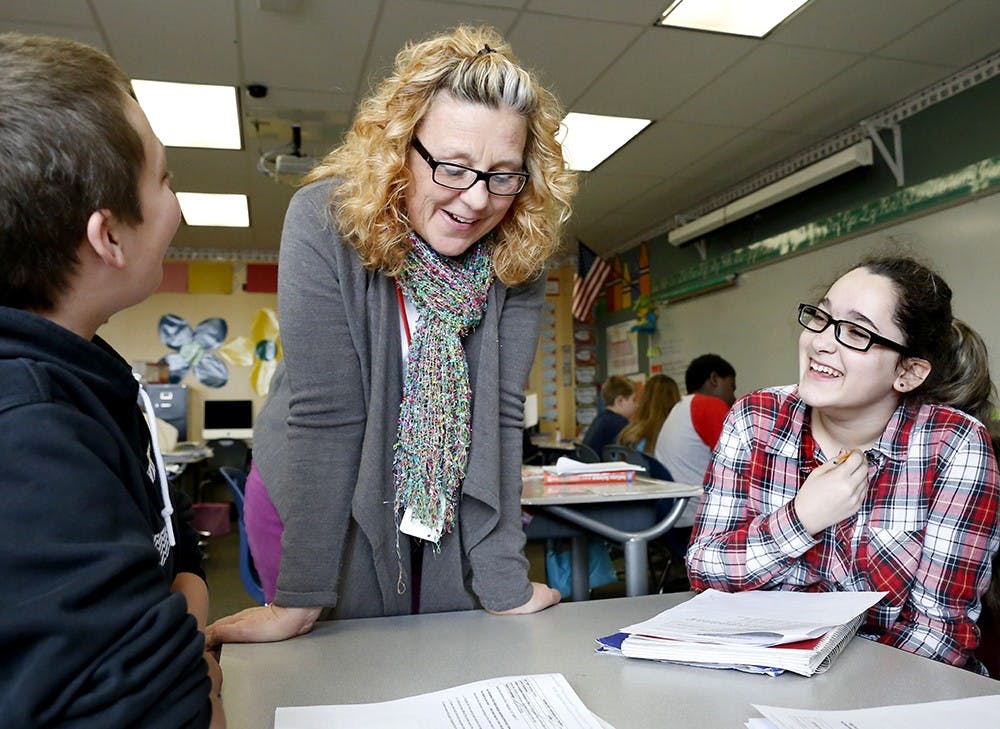In Julie Bryant’s classroom at Fairview Elementary School, a poster with a countdown to this year’s ISTEP test was stapled next to the periodic table of elements, literary genres and motivational posters.
“The Countdown Begins!! 3 Days Until ISTEP,” it read Wednesday afternoon.
Bryant was new at Fairview Elementary last year after transferring from Indianapolis Public Schools. She has a reputation for being stern at the school, but she said she does so to help students succeed.
Before last year, Fairview received three consecutive F ratings, but through a new principal and teachers like Bryant who target problem areas among students, the school was able to earn a C rating after last year’s ISTEP testing.
Bryant has mixed views on the grading scale for schools.
“It’s a double-edged sword,” she said. “I think that we need something to make schools accountable, because if we don’t make schools accountable nothing gets better. Yet, I think too much emphasis is placed on one test — that’s what I have a problem with.”
One way for schools to earn points is through showing improvement in different test sections. Fairview improved immensely in test scores last school year, principal Justin Hunter said.
The bottom 25 percent and the top 75 percent of Fairview’s student population have shown growth in many academic testing areas, Hunter said.
House Bill 1395, which will implement a 22-member committee to consider replacements to the ISTEP test in the 2017-2018 year, is currently in legislation. If passed, the bill could have major effects on the ways students are tested.
Hunter entered an F-rated school with a goal of improving learning through many different strategies.
One of those strategies was implementing intervention programs to target specific issues students were facing.
These intervention programs work as a supplement to the students’ classwork. Students would have 90 minutes of in-class reading and 30 minutes of intervention, Hunter said.
These interventions seek to close gaps and discrepancies on test scores between Fairview and other schools within the district and the state, Hunter said.
“It was extreme, intentional strategies coupled with outstanding community collaborators with excellent staff who saw the need for urgency,” he said.
Fairview looked at gaps in reading vocabulary between the school and the district and state, Hunter said. Other gaps included third-, fourth- and fifth-grade reading comprehension and sixth-grade literary response and analysis, he said.
This was done in a similar way for gaps in mathematical areas.
By using data from ISTEP tests, Fairview was able to pinpoint where students were having trouble and implement interventions and strategies to improve, Hunter said. The school was also able to work with the community on mentorship programs.
“I think we still have some areas to work on with improving our continuity of partners,” Hunter said. “Other areas of opportunity are ensuring that our interventions are meeting those needs for the gaps and strengthening the instructional core and making sure our students are able to illustrate their academic gains in real life environments.”
Bryant walked to each table of students and either praised or scolded them, depending on their efforts.
“Is that your best work?” she said to one student.
Bryant circled the room many times prompting straighter postures and better attention.
The students were in groups reading a story from a packet and answering questions about the story in preparation for their upcoming ISTEP tests.
“How were these characters judged by their looks?” Bryant said to another student. The student thought for a moment before searching through her packet once more.
Several students pointed to each word as they read aloud. One student even gave voices to each new character within the story. Another pair of students argued whether a word was “excerpt” or “expert.”
Bryant is firm with her students, but she said she does it out of love for the children and that they know she wants them to succeed. Bryant said she is probably the firmest person in the building but has the highest results.
“If you give them an inch, they’ll take a mile,” she said. “I’m working on making them confident, independent thinkers with the confidence to know it’s okay to try — it’s okay to fail, but you’ve got to try. I think that’s what we need to work on.”
Sixth-grader Will Kehoe said he enjoys attending Fairview Elementary, as long as students behave.
“It’s been pretty fun,” Kehoe said. “As long as people don’t act out, it’s a great place to go, and if you have Mrs. Bryant it’s great because she’s a great teacher.”
Another sixth-grader, Amber Hoene, said she also enjoys attending Fairview.
“I think it’s really cool, because I like how my teacher teaches me,” she said. “I learn a lot, and I’m very smart now.”
Bryant said she has noticed there is a clear focus among the staff, many of whom have been hired recently, and that the new intervention program has caused the more experienced teachers to change what they were teaching.
Hunter said his opinion of Fairview is not based on a letter grade, but rather on the students, the staff and their work ethic within the school.
“An A or an F does not validate us for who we are,” he said. “We are somebody prior to the letter-grading system. Even though we are cautiously excited about that C, we do not rest our hat on a letter grade. We rest our hat on the fact that our students become thriving citizens.”






